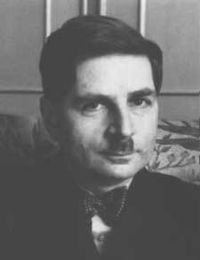Major scientific achievements
In 1914, Schottky developed the well-known classical formula, written here as
 .
.
This computes the interaction energy between a point charge q and a flat metal surface, when the charge is at a distance x from the surface. Owing to the method of its derivation, this interaction is called the "image potential energy" (image PE). Schottky based his work on earlier work by Lord Kelvin relating to the image PE for a sphere. Schottky's image PE has become a standard component in simple models of the barrier to motion, M(x), experienced by an electron on approaching a metal surface or a metal–semiconductor interface from the inside. (This M(x) is the quantity that appears when the one-dimensional, one-particle, Schrödinger equation is written in the form

Here,  is Planck's constant divided by 2π, and m is the electron mass.)
is Planck's constant divided by 2π, and m is the electron mass.)
The image PE is usually combined with terms relating to an applied electric field F and to the height h (in the absence of any field) of the barrier. This leads to the following expression for the dependence of the barrier energy on distance x, measured from the "electrical surface" of the metal, into the vacuum or into the semiconductor:

Here, e is the elementary positive charge, ε0 is the electric constant and εr is the relative permittivity of the second medium (=1 for vacuum). In the case of a metal–semiconductor junction, this is called a Schottky barrier; in the case of the metal-vacuum interface, this is sometimes called a Schottky–Nordheim barrier. In many contexts, h has to be taken equal to the local work function φ.
This Schottky–Nordheim barrier (SN barrier) has played an important role in the theories of thermionic emission and of field electron emission. Applying the field causes lowering of the barrier, and thus enhances the emission current in thermionic emission. This is called the "Schottky effect", and the resulting emission regime is called "Schottky emission".
In 1923 Schottky suggested (incorrectly) that the experimental phenomenon then called autoelectronic emission and now called field electron emission resulted when the barrier was pulled down to zero. In fact, the effect is due to wave-mechanical tunneling, as shown by Fowler and Nordheim in 1928. But the SN barrier has now become the standard model for the tunneling barrier.
Later, in the context of semiconductor devices, it was suggested that a similar barrier should exist at the junction of a metal and a semiconductor. Such barriers are now widely known as Schottky barriers, and considerations apply to the transfer of electrons across them that are analogous to the older considerations of how electrons are emitted from a metal into vacuum. (Basically, several emission regimes exist, for different combinations of field and temperature. The different regimes are governed by different approximate formulae.)
When the whole behaviour of such interfaces is examined, it is found that they can act (asymmetrically) as a special form of electronic diode, now called a Schottky diode. In this context, the metal–semiconductor junction is known as a "Schottky (rectifying) contact'".
Schottky's contributions in surface science/emission electronics and in semiconductor-device theory now form a significant and pervasive part of the background to these subjects. It could possibly be argued that – perhaps because they are in the area of technical physics – they are not as generally well recognized as they ought to be.




